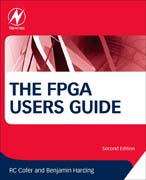
The FPGA Users Guide gives both an explanation of the essential technology of FPGAs and practical guidance on implementation, making it highly suitable for engineers, design managers and system engineers. The real-world insight, recommendations and best practices provided will enable design teams to implement a more efficient design flow, leading to earlier product deliveries with optimized performance and extended design life cycles. Very experienced, 'in-the-trenches', author teamEnd of chapter summaries of key FPGA design skillsChecklists on what is needed to be done to be successful INDICE: 1. Introduction and Lessons Learned 2. FPGA Fundamentals and Applications 3. Optimizing the Development Cycle 4. System Engineering 5. FPGA Device-level Design Decisions 6. Board-Level Design Decisions and Allocation 7. Design Implementation 8. Design Simulation 9. Design Constraints and Optimization 10. Design Configuration 11. Board Level Design integration, Debug and Testing 12. FPGA Design Life Expectancy Obsolescence 13. (Other Topics: Design Configuration Control, Archiving, Documentation and Deliverables) 14. FPGA Design Special Topics 15. Advanced Topics Introduction and Overview 16. Cores and Intellectual Property 17. Embedded Processing Cores 18. Digital Signal Processing 19. Advanced Interconnect 20. Bringing It All Together Appendix A - Abbreviations and Acronyms Appendix B - Design Phases, Milestones, and Gates Checklists Appendix C - References
- ISBN: 978-0-12-804637-1
- Editorial: Newnes
- Encuadernacion: Rústica
- Páginas: 525
- Fecha Publicación: 01/11/2018
- Nº Volúmenes: 1
- Idioma: Inglés
